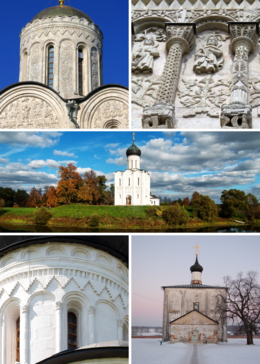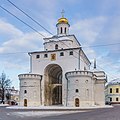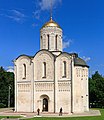The Golden Ring of Russia unites old Russian cities of five Oblasts – usually excluding Moscow – as a well-known theme-route. The grouping is centred northeast of the capital in what was the north-eastern part of ancient Rus'. The ring formerly comprised the region known as Zalesye. The idea of the route and the term was created in 1967 by Soviet historian and essayist Yuri Bychkov, who published in Sovetskaya Kultura in November–December 1967 a series of essays on the cities under the heading: "Golden Ring". Bychkov was one of the founders of ВООПИК: the All-Russian Society for the Protection of Monuments of History and Culture.

Vladimir-Suzdal, also Vladimir-Suzdalian Rus', formally known as the Grand Duchy of Vladimir (1157–1331), was one of the major principalities that succeeded Kievan Rus' in the late 12th century, centered in Vladimir-on-Klyazma. With time the principality grew into a grand duchy divided into several smaller principalities. After being conquered by the Mongol Empire, the principality became a self-governed state headed by its own nobility. A governorship of principality, however, was prescribed by a jarlig issued from the Golden Horde to a Rurikid sovereign.

Vladimir is a city and the administrative center of Vladimir Oblast, Russia, located on the Klyazma River, 200 kilometers (120 mi) east of Moscow. It is served by a railway and the M7 motorway. Population: 349,951 (2021 Census).

Suzdal is a town that serves as the administrative center of Suzdalsky District in Vladimir Oblast, Russia, which is located on the Kamenka River, 26 kilometers (16 mi) north of the city of Vladimir. Vladimir is the administrative center of the surrounding oblast. As of the 2021 Census, its population was 9,286.

Saint Sophia Cathedral in Kyiv, Ukraine, is an architectural monument of Kievan Rus'. The former cathedral is one of the city's best known landmarks and the first heritage site in Ukraine to be inscribed on the World Heritage List along with the Kyiv Cave Monastery complex. Aside from its main building, the cathedral includes an ensemble of supporting structures such as a bell tower and the House of Metropolitan. In 2011 the historic site was reassigned from the jurisdiction of the Ministry of Regional Development of Ukraine to the Ministry of Culture of Ukraine. One of the reasons for the move was that both Saint Sophia Cathedral and Kyiv Pechersk Lavra are recognized by the UNESCO World Heritage Program as one complex, while in Ukraine the two were governed by different government entities. It is currently a museum.

Andrew I, his Russian name in full, Andrey Yuryevich Bogolyubsky, was Grand prince of Vladimir-Suzdal from 1157 until his death. Andrey accompanied Yuri I Vladimirovich, his father, on a conquest of Kiev, then led the devastation of the same city in 1169, and oversaw the elevation of Vladimir as the new capital of northeastern Rus'. He was canonized as a saint in the Russian Orthodox Church in 1702.

The architecture of Russia refers to the architecture of modern Russia as well as the architecture of both the original Kievan Rus’ state, the Russian principalities, and Imperial Russia. Due to the geographical size of modern and imperial Russia, it typically refers to architecture built in European Russia, as well as European influenced architecture in the conquered territories of the Empire.

The Church of the Intercession on the Nerl is a Russian Orthodox church and a symbol of medieval Russia. Dedicated to the Intercession of the Theotokos, the church is situated at the confluence of the Nerl and the Klyazma in Bogolyubovo, Vladimir Oblast, 13 km (8.1 mi) north-east of the ancient capital of Vladimir.

The Dormition Cathedral in Vladimir was a mother church of Medieval Russia in the 13th and 14th centuries. It is part of a World Heritage Site, the White Monuments of Vladimir and Suzdal.

The Golden Gate of Vladimir, constructed between 1158 and 1164, is the only preserved ancient Russian city gate. A museum inside focuses on the history of the Mongol invasion of Russia in the 13th century.

The architecture of Kievan Rus' comes from the medieval state of Kievan Rus' which incorporated parts of what is now modern Ukraine, Russia, and Belarus, and was centered on Kiev and Novgorod. Its architecture is the earliest period of Russian architecture, using the foundations of Byzantine culture but with great use of innovations and architectural features. Most remains are Russian Orthodox churches or parts of the gates and fortifications of cities.

Bogolyubovo is a rural locality in Suzdalsky District of Vladimir Oblast, Russia, located some 10 kilometers (6.2 mi) northeast of Vladimir, the administrative center of the oblast. Population: 4,729 (2021 Census); 4,494 (2010 Census); 4,218 (2002 Census); 4,143 (1989 Census); 3,900 (1969).

Vysokopetrovsky Monastery is a Russian Orthodox monastery in the Bely Gorod area of Moscow, commanding a hill whence Petrovka Street descends towards the Kremlin.
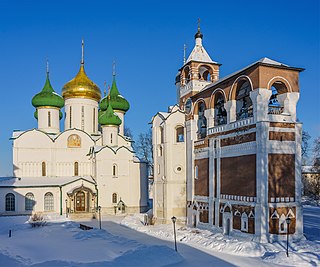
The Saviour Monastery of St. Euthymius is a monastery in Suzdal, Russia, founded in 1352.

The Theotokos of Bogolyubovo, or Bogolubovo Icon, is a Theotokos Agiosoritissa, a type of Marian icon, which is venerated and perceived as wonderworking by the Russian Orthodox Church. The icon was painted in 1157 at the request of Grand Prince Andrew Bogolubsky, in commemoration of an appearance to him by the Mother of God.
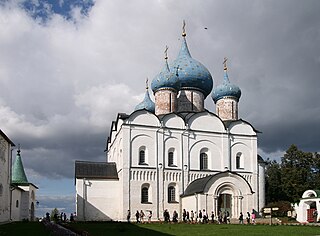
The Cathedral of the Nativity of the Theotokos in Suzdal, Russia, is a World Heritage Site. It is one of the eight White Monuments of Vladimir and Suzdal and one of the most complex monuments of Russian medieval architecture. It was originally constructed during the reign of Vladimir II Monomakh in the late 11th century.

The Suzdal Kremlin is the oldest part of the city of Suzdal, Russia, dating from the 10th century. Like other Russian kremlins, it was originally a fortress or citadel and was the religious and administrative center of the city. It is most notably the site of the Cathedral of the Nativity.

Saint George Cathedral in Yuryev-Polsky is one of a dozen surviving white-stone churches which were built in Vladimir-Suzdal Principality in the northeastern Rus prior to the Mongol invasion. Constructed between 1230 and 1234, the cathedral was also the last of these churches to be built, completed just three years before the invasion. Unlike most of the other pre-Mongol Vladimir-Suzdal churches, the St. George Cathedral was not designated as the World Heritage site.

The Cathedral of Saint Demetrius is a cathedral in the ancient Russian city of Vladimir. It was finished in 1197 during the reign of the Grand Prince Vsevolod the Big Nest of Vladimir-Suzdal to the honour of Saint Demetrius of Thessaloniki. Being an important component of the White Monuments of Vladimir and Suzdal, the cathedral belongs to the World Heritage of UNESCO. Currently, the cathedral is a part of the Vladimir-Suzdal open-air museum.

The Synaxis of all Saints of Vladimir is a holiday in honor of the saints of the Russian Orthodox Church, whose life was connected with the territory of the present Eparchy of Vladimir. It is held on June 23, according to the old style, which falls on July 6 for a new style. The synaxis festival was established in 1982 with the blessing of Patriarch Pimen on the day of the celebration of the Theotokos of Vladimir.
